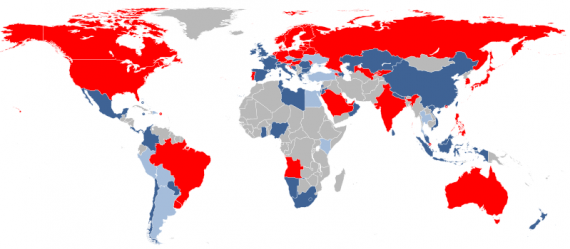Ieri cei de la Wall Street Journal au spus ca iPhone 5 va fi compatibil cu retele 4G LTE internationale, insa nu s-a specificat si pe care dintre aceste retele va functiona dispozitivul, dar in harta de mai sus aveti prezentate tarile in care exista/urmeaza sa fie lansate retele 4G LTE si va puteti imagina cam ce si-a propus Apple. Harta a fost actualizata in luna mai, si colorile de pe ea reprezinta: rosu – tari care au retele comerciale in functiune; albastru inchis – tari care au retele comerciale pregatite pentru lansare; albastru deschis – tari in care au inceput testele retelelor; gri – tari in care nu exista retele LTE lansate sau in dezvoltare.
Dupa cum puteti observa, multe tari dezvoltate au retele active sau in curs de lansare, insa problema este ca in momentul de fata ar fi 41 de benzi diferite pe care functioneaza retelele. Fragmentarea este foarte mare in randul acestor retele, iar in momentul de fata niciun chip baseband nu este capabil sa le suporte pe toate, iar cei de la Qualcomm spun ca nu se stie cand anume va exista un asemenea produs. Deocamdata chip-urile baseband suporta maxim 5 frecvente 4G LTE, deci nici macar un sfert din totalul disponibil la nivel global.
Avand in vedere aceasta diversitate de retele, cu care dintre ele va fi iPhone 5 compatibil? Ei bine stim sigur ca SUA si Canada au retele compatibile cu iPhone 5, iar daca chip-ul baseband din terminal suporta 5 frecvente, atunci 2 dintre ele sunt ocupate cu retelele din SUA si Canada, plus cele ale altor operatori asemanatori, iar restul raman pentru Europa si Asia. In Coreea de Sud, unde Apple ar fi negociat deja lansarea unui iPhone 5 compatibil cu retele 4G LTE, se folosesc benzile de 800 MHz si 1.8 GHz, in Marea Britanie, si probabil in multe tari din Europa, se va folosi tot banda 1.8 GHz, asa ca ramane o singura banda care este utilizata ori de alti operatori din Europa, ori de unii din Asia.
Practic iPhone 5 ar urma sa fie compatibil cu frecventele 700 Mhz, 800 MHz, 1800 MHz si 2100 MHz ale retelelor 4G LTE, iar Apple ar acoperi majoritatea tarilor care au retele active, dar si o buna parte dintre tarile care urmeaza sa lanseze altele. In Romania ar urma sa se utilizeze tot banda de 800 MHz pentru cel putin o parte dintre retelele 4G LTE, deci vom putea utiliza in viitor iDevice-urile fara probleme. iPhone 5 nu va fi compatibil cu fiecare retea de pe glob, insa tarile cele mai importante pentru Apple vor avea retele compatibile, dar ramane de vazut cand vor fi ele lansate.






















